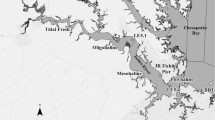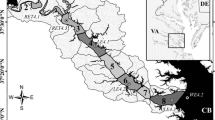Abstract
On August 13, 2004, Hurricane Charley came ashore in the Charlotte Harbor watershed. Surface winds at the time of landfall were estimated at 130 knots. The track of the hurricane roughly followed the floodplain of the Peace River, causing massive defoliation and mortality of native vegetation and planted citrus groves, as well as substantial damage to human habitation and various infrastructure elements. Eight days after landfall, a water quality monitoring effort documented hypoxic (<2 mg I−1) to nearly anaerobic (<0.5 mg I−1) dissolved oxygen (DO) values throughout the vast majority of the Peace River's c. 6,000 km2 watershed. Low DO values appeared to be related to high values of both dissolved organic matter and suspended materials. Hypoxic conditions in Charlotte Harbor itself, occurred within 2 wk of landfall. Approximately 3 wk after the landfall of Hurricane Charley, Hurricane Frances struck the east coast of Florida, causing further wind damage and bringing substantial amounts of rain to the Charlotte Harbor watershed. Three weeks later still, Hurricane Jeanne caused similar damage to the same area. In response to the combined effects of these three hurricanes, DO values in the Peace River did not recover to pre-hurricane levels until approximately 2–3 mo later. The spatial and temporal pattern of DO fluctuations appeared to be related to the proximity of sampling locations to the path of the eyewall of the first of the three hurricanes. Within the Harbor itself, the duration of hypoxic conditions was less than that recorded within the Peace River, perhaps reflecting greater dilution of oxygen-poor waters from the watershed with less-affected water from the Gulf of Mexico.
Similar content being viewed by others
Literature Cited
Boesch, D. F., R. J. Diaz, andR. W. Virnstein. 1976. Effects of Tropical Storm Agnes on soft-bottom macrobenthic communities of the James and York Estuaries and the Iower Chesapeake Bay.Chesapeake Science 17: 246–259
Camp, Dresser, andMcKee, Inc.. 1998. The study of seasonal and spatial patterns of hypoxia in Upper Charlotte Harbor—Final Report. Southwest Florida Water Managment, District, Tampa, Florida.
Coastal Environmental, Inc 1995. Estimates of total nitrogen, total phosphorus, and total suspended solids loadings to Charlotte Harbor, Florida—Final Report. Southwest Florida Water Management District. Tampa, Florida.
Florida Department of Environmental Protection (FDEP) 1996. 305 (b) Report. Tallahassee, Florida.
Lipp, E. K., R. Kurz, R. Vincent, C. Rodriguez-Palacios, S. R. Farrah, andJ. B. Rose. 2001. The effects of seasonal, variability and weather on microbial fecal pollution and enteric pathogens in a subtropical estuary.Estuaries 24: 266–276.
Mallin, M. A., M. H. Posey, M. R. McInver, D. C., Parsons, S. H. Ensign, andT. D. Alphin. 2002. Impacts and recovery from multiple hurricanes in a Piedmont-Coastal Plain river system.Bioscience 52: 999–1010.
Mallin, M. A., M. H. Posey, G. C. Shank, M. R. McIver, S. H. Ensign, andT. D. Alphin 1999. Hurricane effects on water quality and benthos in the Cape Fear watershed: Natural and anthropogenic impacts.Ecological Applications 9: 350–362
Pasch, R. J., D. P. Brown, andE. S. Blake. 2005. Tropical Cyclone Report—Hurricane Charley. National Weather Service, National Hurricane Center, Miami, Florida, http://www.nhc.noaa.gov/2004charley.shtml
Sallenger, A. H., H. F. Stockdon, L. Fauver, M. Hansen, D. Thompson, C. W. Wright, andJ. Lillycrop 2006. Hurricanes 2004: An overivew of their characteristics and coastal change.Estuaries and Coasts 29:880–888
Tabb, D. C. andA. C. Jones. 1962. Effect of Hurricane Donna on aquatic fauna of North Florida Bay.Transactions of the American Fisheries, Society 91: 375–378.
Tilmant, J. T., R. W. Curry, R. Jones, A. Szmant, J. C. Zieman, M. Flora, M. B. Robblee, D. Smith, R. W. Snow, andH. Wanless. 1994. Hurricane Andrew's effect on marine resources.BioScience 44: 230–237.
Turner, R. E., N. N. Rabalais, B. Fry, C. S. Milan, N. Atilla, J. M. Lee, C. Normandeau, T. A. Oswald, E. M. Swenson, andD. A. Tomasko. 2006. Paleo-indicators and water quality change in the Charlotte Harbor estuary (Florida).Limnology and Oceanography 51: 518–533.
Valiela, I., P. Peckol, C. D'Avanzo, K. Lajtha, J. Kremer, W. R. Greyer, K. Foreman, D. Hersh, B. Seely, T. Isaji, andR. Crawford. 1996. Hurricane Bob on Cape Cod.American Scientist 84:154–165
Van Dolah, R. F. andG. S. Anderson 1991. Effects of Hurricane Hugo on salinity and dissolved oxygen conditions in the Charleston Harbor Estuary.Journal of Coastal Research 8:83–94
Author information
Authors and Affiliations
Corresponding author
Rights and permissions
About this article
Cite this article
Tomasko, D.A., Anastasiou, C. & Kovach, C. Dissolved oxygen dynamics in Charlotte Harbor and its contributing watershed, in response to hurricanes Charley, Frances, and Jeanne—Impacts and recovery. Estuaries and Coasts: J ERF 29, 932–938 (2006). https://doi.org/10.1007/BF02798653
Received:
Revised:
Accepted:
Issue Date:
DOI: https://doi.org/10.1007/BF02798653




